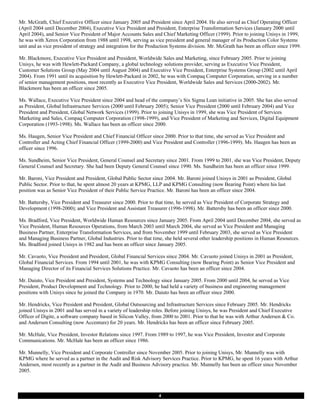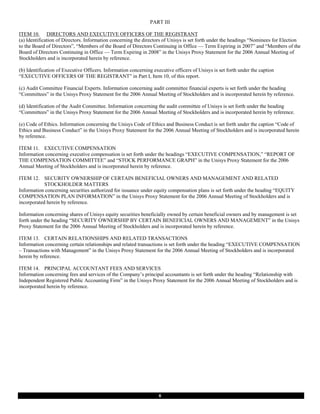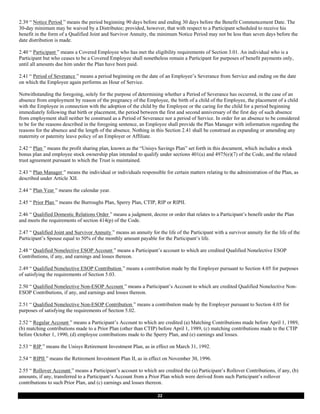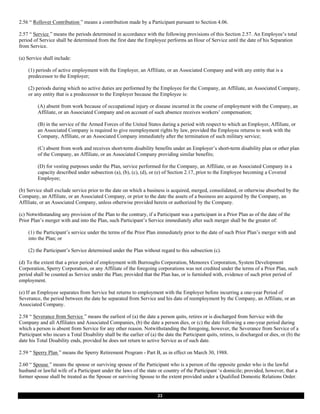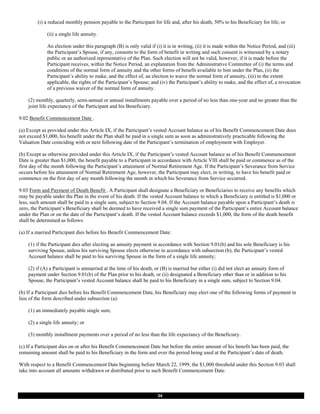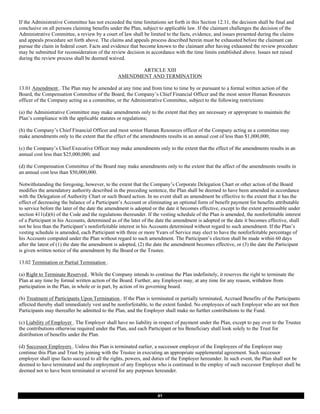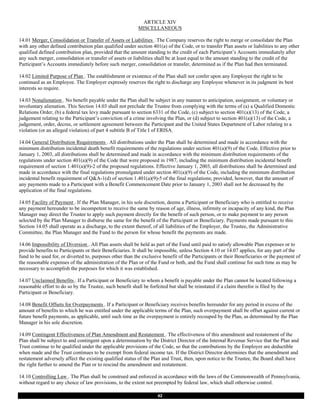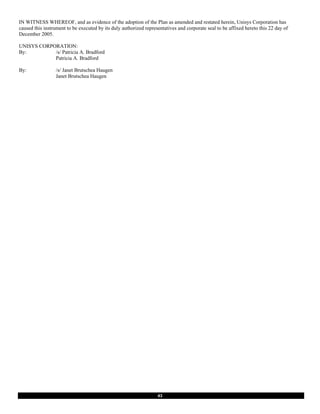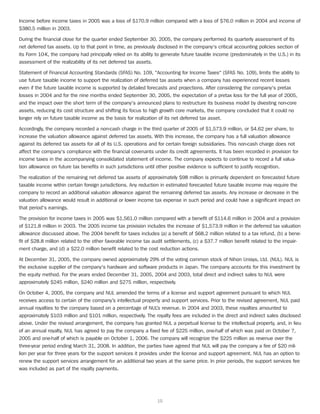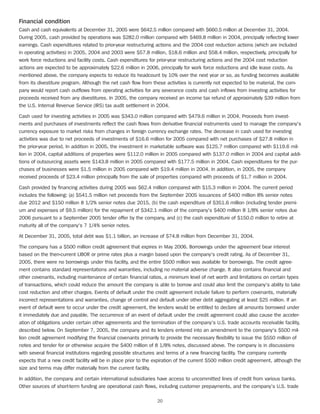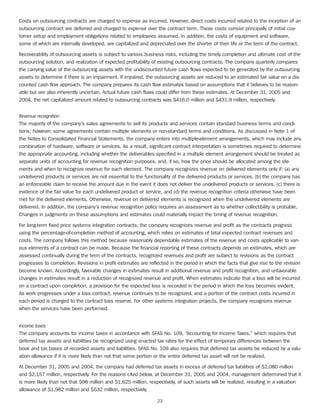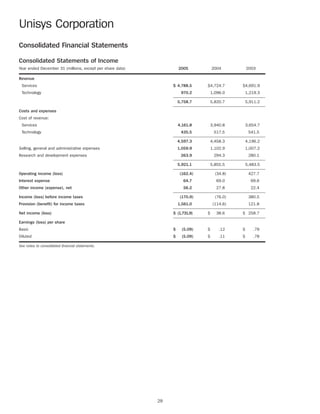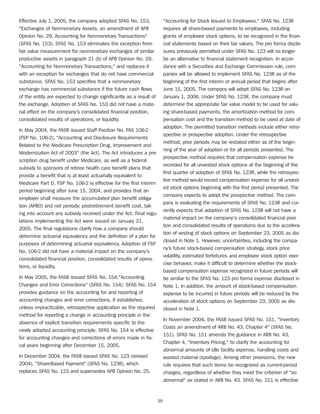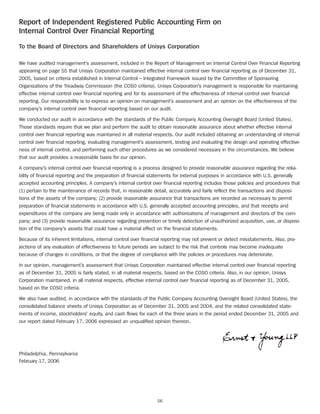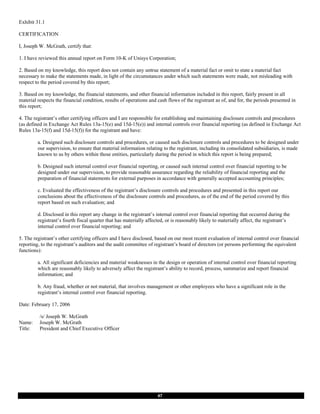unisys 2005_4Q_10K
- 1. UNITED STATES SECURITIES AND EXCHANGE COMMISSION WASHINGTON, D.C. 20549 FORM 10-K (Mark One) ⌧ ANNUAL REPORT PURSUANT TO SECTION 13 OR 15(d) OF THE SECURITIES EXCHANGE ACT OF 1934 For the fiscal year ended December 31, 2005 OR TRANSITION REPORT PURSUANT TO SECTION 13 OR 15(d) OF THE SECURITIES EXCHANGE ACT OF 1934 For the transition period from to . Commission file number: 1-8729 UNISYS CORPORATION (Exact name of registrant as specified in its charter) Delaware - (State or other jurisdiction of (I.R.S. Employer incorporation or organization) Identification No.) Unisys Way Blue Bell, Pennsylvania 19424 (Address of principal executive offices) (Zip Code) Registrant’s telephone number, including area code: (215) 986-4011 Securities registered pursuant to Section 12(b) of the Act: Name of each exchange on Title of each class which registered New York Stock Exchange Securities registered pursuant to Section 12(g) of the Act: None Indicate by check mark if the registrant is a well-known seasoned issuer, as defined in Securities Act Rule 405. ⌧ Yes No Yes ⌧ Indicate by check mark if the registrant is not required to file reports pursuant to Section 13 and Section 15(d) of the Act. No Indicate by check mark whether the registrant (1) has filed all reports required to be filed by Section 13 or 15(d) of the Securities Exchange Act of 1934 during the preceding 12 months (or for such shorter period that the registrant was required to file such reports), and (2) has been subject to such filing requirements for the past 90 days. ⌧ Yes No Indicate by check mark if disclosure of delinquent filers pursuant to Item 405 of Regulation S-K is not contained herein, and will not be contained, to the best of registrant’s knowledge, in definitive proxy or information statements incorporated by reference in Part III of this Form 10-K or any amendment to this Form 10-K. ⌧ Yes No Indicate by check mark whether the registrant is a large accelerated filer, an accelerated filer, or a non-accelerated filer (as defined in Exchange Act Rule 12b-2). Large accelerated filer ⌧ Accelerated filer Non-accelerated filer Yes ⌧ Indicate by check mark whether the registrant is a shell company (as defined in Exchange Act Rule 12b-2). No Aggregate market value of the voting and non-voting common equity held by non-affiliates as of the last business day of the registrant’s most recently completed second fiscal quarter: approximately $2.1 billion. The amount shown is based on the closing price of Unisys Common Stock as reported on the New York Stock Exchange composite tape on June 30, 2005. Voting stock beneficially held by officers and directors is not included in the computation. However, Unisys Corporation has not determined that such individuals are “affiliates” within the meaning of Rule 405 under the Securities Act of 1933. Number of shares of Unisys Common Stock, par value $.01, outstanding as of December 31, 2005: 341,966,150 DOCUMENTS INCORPORATED BY REFERENCE Portions of the Unisys Corporation 2005 Annual Report to Stockholders — Part I, Part II and Part IV. Portions of the Unisys Corporation Proxy Statement for the 2006 Annual Meeting of Stockholders — Part III
- 2. PART I ITEM 1. BUSINESS Unisys Corporation (“Unisys” or the “Company”) is a worldwide technology services and solutions company. The Company’s consultants apply Unisys expertise in consulting, systems integration, outsourcing, infrastructure, and server technology to help clients achieve secure business operations. Unisys has two business segments — Services and Technology. Financial information concerning the two segments is set forth in Note 17, “Segment information”, of the Notes to Consolidated Financial Statements appearing in the Unisys 2005 Annual Report to Stockholders, and such information is incorporated herein by reference. The principal executive offices of Unisys are located at Unisys Way, Blue Bell, Pennsylvania 19424. Principal Products and Services Unisys provides services and technology to commercial businesses and governments throughout most of the world. In the Services segment, Unisys provides end-to-end services and solutions designed to help clients improve their competitiveness and efficiency in the global marketplace. The Unisys portfolio of solutions and services includes systems integration and consulting; outsourcing, including the management of a customer’s internal information systems and management of specific business processes, such as check processing, insurance claims processing, health claims processing, mortgage administration and cargo management; infrastructure services involving the design and support of customers’ IT infrastructure, including desktops, servers, mobile and wireless systems, and networks; enterprise-wide security solutions to protect systems, networks, applications and data; and core maintenance (maintenance on Unisys proprietary products). In the Technology segment, Unisys develops servers and related products that operate in transaction-intensive, mission-critical environments. Major offerings include enterprise-class servers based on the Unisys Cellular MultiProcessing architecture, such as the ClearPath Plus family of servers, which integrates proprietary and “open” platforms, and the ES7000 family of servers, which provide enterprise-class attributes on Intel-based servers; operating system software and middleware to power high-end servers; and specialized technologies such as payment systems, chip testing and third-party products. The primary vertical markets Unisys serves worldwide include financial services, communications, transportation, commercial, and public sector, including the U.S. federal government. Products and services are marketed primarily through a direct sales force. In certain foreign countries, Unisys markets primarily through distributors. Materials Unisys purchases components and supplies from a number of suppliers around the world. For certain technology products, the Company relies on a single or limited number of suppliers, although the Company makes every effort to assure that alternative sources are available if the need arises. The failure of the Company’s suppliers to deliver components and supplies in sufficient quantities and in a timely manner could adversely affect the Company’s business. Patents, Trademarks and Licenses Unisys owns many domestic and foreign patents relating to the design and manufacture of its products, has granted licenses under certain of its patents to others and is licensed under the patents of others. Unisys does not believe that its business is materially dependent upon any single patent or license or related group thereof. Trademarks and service marks used on or in connection with Unisys products and services are considered to be valuable assets of Unisys. Seasonality The Company’s revenue is affected by such factors as the introduction of new products and services, the length of sales cycles and the seasonality of purchases. Seasonality has generally resulted in higher fourth quarter revenue than in other quarters. Customers No single customer accounts for more than 10% of Unisys revenue. Sales of commercial products and services to various agencies of the U.S. government represented 17% of total consolidated revenue in 2005. 1
- 3. Backlog In the Services segment, firm order backlog at December 31, 2005 was $6.4 billion, compared to $6.8 billion at December 31, 2004. Approximately $2.8 billion (44%) of 2005 backlog is expected to be filled in 2006. Although the Company believes that this backlog is firm, the Company may, for commercial reasons, allow the orders to be cancelled, with or without penalty. In addition, funded government contracts included in this backlog are generally subject to termination, in whole or part, at the convenience of the government or if funding becomes unavailable. In such cases, the Company is generally entitled to receive payment for work completed plus allowable termination or cancellation costs. At the end of 2005, the Company also had $2.3 billion of potential future Services order value which it may receive under certain multi-year U.S. government contracts for which funding is appropriated annually. The comparable value of unfunded multi-year U.S. government contracts at the end of 2004 was $2.4 billion. Because of the relatively short cycle between order and shipment in its Technology segment, the Company believes that backlog information for this segment is not material to the understanding of its business. Competition Unisys business is affected by rapid change in technology in the information services and technology industries and aggressive competition from many domestic and foreign companies. Principal competitors are systems integrators, consulting and other professional services firms, outsourcing providers, infrastructure services providers, computer hardware manufacturers and software providers. Unisys competes primarily on the basis of service, product performance, technological innovation, and price. Unisys believes that its continued investment in engineering and research and development, coupled with its marketing capabilities, will have a favorable impact on its competitive position. Research and Development Unisys-sponsored research and development costs were $263.9 million in 2005, $294.3 million in 2004, and $280.1 million in 2003. Environmental Matters Capital expenditures, earnings and the competitive position of Unisys have not been materially affected by compliance with federal, state and local laws regulating the protection of the environment. Capital expenditures for environmental control facilities are not expected to be material in 2006 and 2007. Employees As of December 31, 2005, Unisys had approximately 36,100 employees. Unisys uses the title “partner” for certain members of its services business management. In using the term “partner” or “partners,” Unisys does not mean to imply that these individuals are partners in the legal sense or to imply any intention to create a separate legal entity, such as a partnership. International and Domestic Operations Financial information by geographic area is set forth in Note 17, “Segment information”, of the Notes to Consolidated Financial Statements appearing in the Unisys 2005 Annual Report to Stockholders, and such information is incorporated herein by reference. Available Information Unisys makes available, free of charge through its Internet web site at http://www.unisys.com/about _unisys/investors, its annual report on Form 10-K, quarterly reports on Form 10-Q, current reports on Form 8-K, and amendments to those reports filed or furnished pursuant to Section 13(a) or 15(d) of the Securities Exchange Act of 1934, as soon as reasonably practicable after such material is electronically filed with or furnished to the SEC. Unisys also makes available on its Internet website its Guidelines on Significant Corporate Governance Issues, the charters of the Audit Committee, Compensation Committee, Finance Committee, and Nominating and Corporate Governance Committee of its board of directors, and its Code of Ethics and Business Conduct. Such information is also available in print to stockholders upon request. 2
- 4. ITEM 1A. RISK FACTORS Discussion of risk factors is set forth under the heading “Factors that may affect future results” in “Management’s Discussion and Analysis of Financial Condition and Results of Operations” in the Unisys 2005 Annual Report to Stockholders and is incorporated herein by reference. ITEM 1B. UNRESOLVED STAFF COMMENTS Not applicable. ITEM 2. PROPERTIES As of December 31, 2005, Unisys had 21 major facilities in the United States with an aggregate floor space of approximately 4.6 million square feet, located primarily in California, Georgia, Michigan, Minnesota, New Jersey, Pennsylvania, Utah and Virginia. Two of these facilities, with aggregate floor space of approximately 1.0 million square feet, were owned by Unisys and 19, with approximately 3.6 million square feet of floor space, were leased to Unisys. Approximately 3.9 million square feet of the U.S. facilities were in current operation, approximately .2 million square feet were subleased to others, and approximately .5 million square feet were being held in reserve or were declared surplus with disposition efforts in progress. As of December 31, 2005, Unisys had 23 major facilities outside the United States with an aggregate floor space of approximately 2.5 million square feet, located primarily in Australia, Brazil, France, Germany, India, Netherlands, South Africa, Switzerland and the United Kingdom. Four of these facilities, with approximately .7 million square feet of floor space, were owned by Unisys and 19, with approximately 1.8 million square feet of floor space, were leased to Unisys. Approximately 1.8 million square feet were in current operation, approximately .2 million square feet were subleased to others, and approximately .5 million square feet were being held in reserve or were declared surplus with disposition efforts in progress. Unisys major facilities include offices, laboratories, centers of excellence, manufacturing plants, warehouses, and distribution and sales centers. Unisys believes that its facilities are suitable and adequate for current and presently projected needs. Unisys continuously reviews its anticipated requirements for facilities and will from time to time acquire additional facilities, expand existing facilities, and dispose of existing facilities or parts thereof, as necessary. ITEM 3. LEGAL PROCEEDINGS As of the date of filing of this report, Unisys has no material legal proceedings required to be disclosed under this Item 3. ITEM 4. SUBMISSION OF MATTERS TO A VOTE OF SECURITY HOLDERS No matters were submitted to a vote of security holders of Unisys during the fourth quarter of 2005. ITEM 10. EXECUTIVE OFFICERS OF THE REGISTRANT Information concerning the executive officers of Unisys as of February 1, 2006 is set forth below. Name Age Position with Unisys Joseph W. McGrath 53 President and Chief Executive Officer Peter Blackmore 58 Executive Vice President; President, Worldwide Sales and Marketing Janet B. Wallace 54 Executive Vice President Janet Brutschea Haugen 47 Senior Vice President and Chief Financial Officer Nancy Straus Sundheim 54 Senior Vice President, General Counsel and Secretary Greg T. Baroni 52 Vice President; President, Global Public Sector Scott A. Battersby 47 Vice President and Treasurer Patricia A. Bradford 55 Vice President, Worldwide Human Resources Dominick Cavuoto 52 Vice President; President, Global Financial Services Leo C. Daiuto 60 Vice President; President, Systems and Technology Randy J. Hendricks 49 Vice President; President, Global Outsourcing and Infrastructure Services Jack F. McHale 56 Vice President, Investor Relations Joseph M. Munnelly 41 Vice President and Corporate Controller There is no family relationship among any of the above-named executive officers. The By-Laws provide that the officers of Unisys shall be elected annually by the Board of Directors and that each officer shall hold office for a term of one year and until a successor is elected and qualified, or until the officer’s earlier resignation or removal. 3
- 5. Mr. McGrath, Chief Executive Officer since January 2005 and President since April 2004. He also served as Chief Operating Officer (April 2004 until December 2004), Executive Vice President and President, Enterprise Transformation Services (January 2000 until April 2004), and Senior Vice President of Major Accounts Sales and Chief Marketing Officer (1999). Prior to joining Unisys in 1999, he was with Xerox Corporation from 1988 until 1998, serving as vice president and general manager of its Production Color Systems unit and as vice president of strategy and integration for the Production Systems division. Mr. McGrath has been an officer since 1999. Mr. Blackmore, Executive Vice President and President, Worldwide Sales and Marketing, since February 2005. Prior to joining Unisys, he was with Hewlett-Packard Company, a global technology solutions provider, serving as Executive Vice President, Customer Solutions Group (May 2004 until August 2004) and Executive Vice President, Enterprise Systems Group (2002 until April 2004). From 1991 until its acquisition by Hewlett-Packard in 2002, he was with Compaq Computer Corporation, serving in a number of senior management positions, most recently as Executive Vice President, Worldwide Sales and Services (2000-2002). Mr. Blackmore has been an officer since 2005. Ms. Wallace, Executive Vice President since 2004 and head of the company’s Six Sigma Lean initiative in 2005. She has also served as President, Global Infrastructure Services (2000 until February 2005); Senior Vice President (2000 until February 2004) and Vice President and President, Global Network Services (1999). Prior to joining Unisys in 1999, she was Vice President of Services Marketing and Sales, Compaq Computer Corporation (1998-1999), and Vice President of Marketing and Services, Digital Equipment Corporation (1993-1998). Ms. Wallace has been an officer since 2000. Ms. Haugen, Senior Vice President and Chief Financial Officer since 2000. Prior to that time, she served as Vice President and Controller and Acting Chief Financial Officer (1999-2000) and Vice President and Controller (1996-1999). Ms. Haugen has been an officer since 1996. Ms. Sundheim, Senior Vice President, General Counsel and Secretary since 2001. From 1999 to 2001, she was Vice President, Deputy General Counsel and Secretary. She had been Deputy General Counsel since 1990. Ms. Sundheim has been an officer since 1999. Mr. Baroni, Vice President and President, Global Public Sector since 2004. Mr. Baroni joined Unisys in 2001 as President, Global Public Sector. Prior to that, he spent almost 20 years at KPMG, LLP and KPMG Consulting (now Bearing Point) where his last position was as Senior Vice President of their Public Service Practice. Mr. Baroni has been an officer since 2004. Mr. Battersby, Vice President and Treasurer since 2000. Prior to that time, he served as Vice President of Corporate Strategy and Development (1998-2000); and Vice President and Assistant Treasurer (1996-1998). Mr. Battersby has been an officer since 2000. Ms. Bradford, Vice President, Worldwide Human Resources since January 2005. From April 2004 until December 2004, she served as Vice President, Human Resources Operations, from March 2003 until March 2004, she served as Vice President and Managing Business Partner, Enterprise Transformation Services, and from November 1999 until February 2003, she served as Vice President and Managing Business Partner, Global Industries. Prior to that time, she held several other leadership positions in Human Resources. Ms. Bradford joined Unisys in 1982 and has been an officer since January 2005. Mr. Cavuoto, Vice President and President, Global Financial Services since 2004. Mr. Cavuoto joined Unisys in 2001 as President, Global Financial Services. From 1994 until 2001, he was with KPMG Consulting (now Bearing Point) as Senior Vice President and Managing Director of its Financial Services Solutions Practice. Mr. Cavuoto has been an officer since 2004. Mr. Daiuto, Vice President and President, Systems and Technology since January 2005. From 2000 until 2004, he served as Vice President, Product Development and Technology. Prior to 2000, he had held a variety of business and engineering management positions with Unisys since he joined the Company in 1970. Mr. Daiuto has been an officer since 2000. Mr. Hendricks, Vice President and President, Global Outsourcing and Infrastructure Services since February 2005. Mr. Hendricks joined Unisys in 2001 and has served in a variety of leadership roles. Before joining Unisys, he was President and Chief Executive Officer of Digite, a software company based in Silicon Valley, from 2000 to 2001. Prior to that he was with Arthur Andersen & Co. and Andersen Consulting (now Accenture) for 20 years. Mr. Hendricks has been an officer since February 2005. Mr. McHale, Vice President, Investor Relations since 1997. From 1989 to 1997, he was Vice President, Investor and Corporate Communications. Mr. McHale has been an officer since 1986. Mr. Munnelly, Vice President and Corporate Controller since November 2005. Prior to joining Unisys, Mr. Munnelly was with KPMG where he served as a partner in the Audit and Risk Advisory Services Practice. Prior to KPMG, he spent 16 years with Arthur Andersen, most recently as a partner in the Audit and Business Advisory practice. Mr. Munnelly has been an officer since November 2005. 4
- 6. PART II ITEM 5. MARKET FOR THE REGISTRANT’S COMMON EQUITY, RELATED STOCKHOLDER MATTERS AND ISSUER PURCHASES OF EQUITY SECURITIES Unisys Common Stock (trading symbol “UIS”) is listed for trading on the New York Stock Exchange, on exchanges in Amsterdam, Brussels, and London and on the SWX Swiss Exchange. Information on the high and low sales prices for Unisys Common Stock is set forth under the heading “Quarterly financial information” in the Unisys 2005 Annual Report to Stockholders and is incorporated herein by reference. At December 31, 2005, there were approximately 342.0 million shares outstanding and approximately 24,000 stockholders of record. Unisys has not declared or paid any cash dividends on its Common Stock since 1990 and does not anticipate declaring or paying cash dividends in the foreseeable future. ITEM 6. SELECTED FINANCIAL DATA A summary of selected financial data for Unisys is set forth under the heading “Five-year summary of selected financial data” in the Unisys 2005 Annual Report to Stockholders and is incorporated herein by reference. ITEM 7. MANAGEMENT’S DISCUSSION AND ANALYSIS OF FINANCIAL CONDITION AND RESULTS OF OPERATIONS Management’s discussion and analysis of financial condition and results of operations is set forth under the heading “Management’s Discussion and Analysis of Financial Condition and Results of Operations” in the Unisys 2005 Annual Report to Stockholders and is incorporated herein by reference. ITEM 7A. QUANTITATIVE AND QUALITATIVE DISCLOSURES ABOUT MARKET RISK Information concerning market risk is set forth under the heading “Market risk” in “Management’s Discussion and Analysis of Financial Condition and Results of Operations” in the Unisys 2005 Annual Report to Stockholders and is incorporated herein by reference. ITEM 8. FINANCIAL STATEMENTS AND SUPPLEMENTARY DATA The following documents appearing in the Company’s 2005 Annual Report to Stockholders for the year ended December 31, 2005 are incorporated herein by reference: • Consolidated Financial Statements • Report of Independent Registered Public Accounting Firm on the Financial Statements • Quarterly financial information • Report of Management on Internal Control Over Financial Reporting • Report of Independent Registered Public Accounting Firm on Internal Control Over Financial Reporting ITEM 9. CHANGES IN AND DISAGREEMENTS WITH ACCOUNTANTS ON ACCOUNTING AND FINANCIAL DISCLOSURE Not applicable. ITEM 9A. CONTROLS AND PROCEDURES (a) Disclosure Controls and Procedures; Changes in Internal Control Over Financial Reporting The Company’s management, with the participation of the Company’s Chief Executive Officer and Chief Financial Officer, has evaluated the effectiveness of the Company’s disclosure controls and procedures (as defined in Rules 13a-15(e) of the Securities Exchange Act of 1934) as of December 31, 2005. Based on that evaluation, the Company’s Chief Executive Officer and Chief Financial Officer concluded that the Company’s disclosure controls and procedures are effective for gathering, analyzing and disclosing the information the Company is required to disclose in the reports it files under the Securities Exchange Act of 1934, within the time periods specified in the SEC’s rules and forms. During the fourth quarter of 2005, the Company recorded certain accounting adjustments at its federal government group operations. The Company’s corporate monitoring controls identified these issues prior to year end. In response to these issues, the Company is taking steps to strengthen its control processes at its federal government group operations. Among other things, the Company has added new personnel resources and enhanced certain reconciliation processes. The matter noted above has been discussed with the Company’s Audit Committee. (b) Management’s Report on Internal Control Over Financial Reporting; Attestation Report of Independent Registered Public Accounting Firm Management’s report on internal control over financial reporting and the attestation report of Ernst & Young LLP thereon are set forth under the headings “Report of Management on Internal Control over Financial Reporting” and “Report of Independent Registered Public Accounting Firm on Internal Control Over Financial Reporting” in the Unisys 2005 Annual Report to Stockholders, and are incorporated herein by reference. ITEM 9B. OTHER INFORMATION Not applicable. 5
- 7. PART III ITEM 10. DIRECTORS AND EXECUTIVE OFFICERS OF THE REGISTRANT (a) Identification of Directors. Information concerning the directors of Unisys is set forth under the headings “Nominees for Election to the Board of Directors”, “Members of the Board of Directors Continuing in Office — Term Expiring in 2007” and “Members of the Board of Directors Continuing in Office — Term Expiring in 2008” in the Unisys Proxy Statement for the 2006 Annual Meeting of Stockholders and is incorporated herein by reference. (b) Identification of Executive Officers. Information concerning executive officers of Unisys is set forth under the caption “EXECUTIVE OFFICERS OF THE REGISTRANT” in Part I, Item 10, of this report. (c) Audit Committee Financial Experts. Information concerning audit committee financial experts is set forth under the heading “Committees” in the Unisys Proxy Statement for the 2006 Annual Meeting of Stockholders and is incorporated herein by reference. (d) Identification of the Audit Committee. Information concerning the audit committee of Unisys is set forth under the heading “Committees” in the Unisys Proxy Statement for the 2006 Annual Meeting of Stockholders and is incorporated herein by reference. (e) Code of Ethics. Information concerning the Unisys Code of Ethics and Business Conduct is set forth under the caption “Code of Ethics and Business Conduct” in the Unisys Proxy Statement for the 2006 Annual Meeting of Stockholders and is incorporated herein by reference. ITEM 11. EXECUTIVE COMPENSATION Information concerning executive compensation is set forth under the headings “EXECUTIVE COMPENSATION,” “REPORT OF THE COMPENSATION COMMITTEE” and “STOCK PERFORMANCE GRAPH” in the Unisys Proxy Statement for the 2006 Annual Meeting of Stockholders and is incorporated herein by reference. ITEM 12. SECURITY OWNERSHIP OF CERTAIN BENEFICIAL OWNERS AND MANAGEMENT AND RELATED STOCKHOLDER MATTERS Information concerning securities authorized for issuance under equity compensation plans is set forth under the heading “EQUITY COMPENSATION PLAN INFORMATION” in the Unisys Proxy Statement for the 2006 Annual Meeting of Stockholders and is incorporated herein by reference. Information concerning shares of Unisys equity securities beneficially owned by certain beneficial owners and by management is set forth under the heading “SECURITY OWNERSHIP BY CERTAIN BENEFICIAL OWNERS AND MANAGEMENT” in the Unisys Proxy Statement for the 2006 Annual Meeting of Stockholders and is incorporated herein by reference. ITEM 13. CERTAIN RELATIONSHIPS AND RELATED TRANSACTIONS Information concerning certain relationships and related transactions is set forth under the heading “EXECUTIVE COMPENSATION – Transactions with Management” in the Unisys Proxy Statement for the 2006 Annual Meeting of Stockholders and is incorporated herein by reference. ITEM 14. PRINCIPAL ACCOUNTANT FEES AND SERVICES Information concerning fees and services of the Company’s principal accountants is set forth under the heading “Relationship with Independent Registered Public Accounting Firm” in the Unisys Proxy Statement for the 2006 Annual Meeting of Stockholders and is incorporated herein by reference. 6
- 8. PART IV ITEM 15. EXHIBITS AND FINANCIAL STATEMENT SCHEDULES The following documents are filed as part of this report: 1. Financial Statements from the Unisys 2005 Annual Report to Stockholders which are incorporated herein by reference: Consolidated Balance Sheets at December 31, 2005 and December 31, 2004 Consolidated Statements of Income for each of the three years in the period ended December 31, 2005 Consolidated Statements of Cash Flows for each of the three years in the period ended December 31, 2005 Consolidated Statements of Stockholders’ Equity for each of the three years in the period ended December 31, 2005 Notes to Consolidated Financial Statements Report of Management on Internal Control over Financial Reporting Reports of Independent Registered Public Accounting Firm 2. Financial Statement Schedules filed as part of this report pursuant to Item 8 of this report: Schedule Number Form 10-K Page No. II Valuation and Qualifying Accounts 15 The financial statement schedule should be read in conjunction with the consolidated financial statements and notes thereto in the Unisys 2005 Annual Report to Stockholders. Financial statement schedules not included with this report have been omitted because they are not applicable or the required information is shown in the consolidated financial statements or notes thereto. Separate financial statements of subsidiaries not consolidated with Unisys and entities in which Unisys has a fifty percent or less ownership interest have been omitted because these operations do not meet any of the conditions set forth in Rule 3-09 of Regulation S-X. 3. Exhibits. Those exhibits required to be filed by Item 601 of Regulation S-K are listed in the Exhibit Index included in this report at pages 16 through 19. Management contracts and compensatory plans and arrangements are listed as Exhibits 10.1 through 10.23. 7
- 9. SIGNATURES Pursuant to the requirements of Section 13 or 15(d) of the Securities Exchange Act of 1934, the registrant has duly caused this report to be signed on its behalf by the undersigned, thereunto duly authorized. UNISYS CORPORATION By: /s/ Joseph W. McGrath Joseph W. McGrath President and Chief Executive Officer Date: February 17, 2006 Pursuant to the requirements of the Securities Exchange Act of 1934, this report has been signed below by the following persons on behalf of the registrant and in the capacities indicated on February 17, 2006. /s/ Joseph W. McGrath *Henry C. Duques Joseph W. McGrath Henry C. Duques President and Chief Executive Officer Chairman of the Board and Director (principal executive officer) and Director /s/ Janet Brutschea Haugen *J. P. Bolduc Janet Brutschea Haugen J. P. Bolduc Senior Vice President and Chief Financial Officer Director (principal financial officer) /s/ Joseph M. Munnelly *James J. Duderstadt Joseph M. Munnelly James J. Duderstadt Vice President and Corporate Controller Director (principal accounting officer) *Matthew J. Espe *Clayton M. Jones Matthew J. Espe Clayton M. Jones Director Director *Denise K. Fletcher Denise K. Fletcher Leslie F. Kenne Director Director *Randall J. Hogan *Theodore M. Martin Randall J. Hogan Theodore M. Martin Director Director *Edwin A. Huston Edwin A. Huston Director *By:/s/ Joseph W. McGrath Joseph W. McGrath Attorney-in-Fact 8
- 10. UNISYS CORPORATION SCHEDULE II - VALUATION AND QUALIFYING ACCOUNTS (Millions) Balance at Additions Charged to Balance at End of Beginning of Period Costs & Expenses Deductions (1) Period Description Allowance for Doubtful Accounts (deducted from accounts and notes receivable): Year Ended December 31, 2003 $ 61.8 $ .6 $ (12.6) $ 49.8 Year Ended December 31, 2004 $ 49.8 $ 1.9 $ (2.1) $ 49.6 Year Ended December 31, 2005 $ 49.6 $ 9.0 $ (8.0) $ 50.6 (1) Write-off of bad debts less recoveries. 9
- 11. EXHIBIT INDEX Exhibit Number Description 3.1 Restated Certificate of Incorporation of Unisys Corporation (incorporated by reference to Exhibit 3.1 to the registrant’s Quarterly Report on Form 10-Q for the quarterly period ended September 30, 1999) 3.2 By-Laws of Unisys Corporation, as amended through December 1, 2005 (incorporated by reference to Exhibit 3 to the registrant’s Current Report on Form 8-K dated December 1, 2005) 4.1 Agreement to furnish to the Commission on request a copy of any instrument defining the rights of the holders of long-term debt which authorizes a total amount of debt not exceeding 10% of the total assets of the registrant (incorporated by reference to Exhibit 4 to the registrant’s Annual Report on Form 10-K for the year ended December 31, 1982 (File No. 1-145)) 4.2 Form of Rights Agreement dated as of March 7, 1986, which includes as Exhibit A, the Certificate of Designations for the Junior Participating Preferred Stock, and as Exhibit B, the Form of Rights Certificate (incorporated by reference to Exhibit 1 to the registrant’s Registration Statement on Form 8-A, dated March 11, 1986) 4.3 Amendment No. 1, dated as of February 22, 1996, to Rights Agreement (incorporated by reference to Exhibit 4 to the registrant’s Current Report on Form 8-K dated February 22, 1996) 4.4 Amendment No. 2, dated as of December 7, 2000, to Rights Agreement (incorporated by reference to Exhibit 4 to the registrant’s Current Report on Form 8-K dated December 7, 2000) 10.1 Unisys Corporation Deferred Compensation Plan as amended and restated effective September 22, 2000 (incorporated by reference to Exhibit 10.3 to the registrant’s Quarterly Report on Form 10-Q for the quarterly period ended September 30, 2000) 10.2 Deferred Compensation Plan for Directors of Unisys Corporation, as amended and restated effective April 22, 2004 (incorporated by reference to Exhibit 10.2 to the registrant’s Quarterly Report on Form 10-Q for the quarterly period ended June 30, 2004) 10.3 Unisys Corporation Director Stock Unit Plan, as amended and restated, effective September 22, 2000 (incorporated by reference to Exhibit 10.5 to the registrant’s Quarterly Report on Form 10-Q for the quarterly period ended September 30, 2000) 10.4 Unisys Directors Stock Option Plan, as amended and restated effective September 22, 2000 (incorporated by reference to Exhibit 10.2 to the registrant’s Quarterly Report on Form 10-Q for the quarterly period ended September 30, 2000) 10.5 Unisys Executive Annual Variable Compensation Plan (incorporated by reference to Exhibit A to the registrant’s Proxy Statement, dated March 23, 1993, for its 1993 Annual Meeting of Stockholders) 10.6 1990 Unisys Long-Term Incentive Plan, as amended and restated effective September 22, 2000 (incorporated by reference to Exhibit 10.1 to the registrant’s Quarterly Report on Form 10-Q for the quarterly period ended September 30, 2000) 10.7 Form of Indemnification Agreement between Unisys Corporation and each of its Directors (incorporated by reference to Exhibit B to the registrant’s Proxy Statement, dated March 22, 1988, for the 1988 Annual Meeting of Stockholders) 10.8 Form of Executive Employment Agreement (incorporated by reference to Exhibit 10.1 to the registrant’s Quarterly Report on Form 10-Q for the quarterly period ended June 30, 1995) 10.9 Unisys Corporation 2002 Stock Option Plan (incorporated by reference to Exhibit 10.17 to the registrant’s Annual Report on Form 10-K for the year ended December 31, 2002) 10.10 Unisys Corporation 2003 Long-Term Incentive and Equity Compensation Plan (incorporated by reference to Appendix B to the registrant’s Proxy Statement, dated March 14, 2003, for its 2003 Annual Meeting of Stockholders) 10.11 Agreement, dated April 6, 2004, between Lawrence A. Weinbach and Unisys Corporation (incorporated by reference to Exhibit 10 to the registrant’s Current Report on Form 8-K dated April 6, 2004) 10.12 Agreement, dated December 22, 2004, between Unisys Corporation and Joseph W. McGrath (incorporated by reference to Exhibit 10 to the registrant’s Amendment No. 1 to Current Report on Form 8-K/A dated December 22, 2004) 10.13 Unisys Corporation Supplemental Executive Retirement Income Plan, as amended and restated effective January 1, 2005 (incorporated by reference to Exhibit 10.17 to the registrant’s Annual Report on Form 10-K for the year ended December 31, 2004) 10.14 Unisys Corporation Elected Officer Pension Plan, as amended and restated effective January 1, 2005 (incorporated by reference to Exhibit 10.18 to the registrant’s Annual Report on Form 10-K for the year ended December 31, 2004) 10.15 2005 Deferred Compensation Plan for Directors of Unisys Corporation (incorporated by reference to Exhibit 10.19 to the registrant’s Annual Report on Form 10-K for the year ended December 31, 2004) 10.16 Unisys Corporation 2005 Deferred Compensation Plan (incorporated by reference to Exhibit 10.20 to the registrant’s Annual Report on Form 10-K for the year ended December 31, 2004) 10.17 Description of Turnaround Cash Incentive Program (incorporated by reference to Item 1.01(c) of the registrant’s Current Report on Form 8- K dated February 9, 2006) 10.18 Description of 2006 compensation of directors (incorporated by reference to Item 1.01(d) of the registrant’s Current Report on Form 8-K dated February 9, 2006) 10.19 Consulting Agreement dated as of February 1, 2006 between Unisys Corporation and Lawrence A. Weinbach (incorporated by reference to Exhibit 10.1 to the registrant’s Current Report on Form 8-K dated February 9, 2006) 10.20 Summary of 2006 Salary and Bonus Arrangements with certain executive officers (incorporated by reference to Exhibit 10.2 to the registrant’s Current Report on Form 8-K dated February 9, 2006) 10.21 Unisys Corporation Executive Life Insurance Program, as amended and restated effective April 22, 2004 10.22 Unisys Corporation Savings Plan, as amended and restated effective January 1, 2005 10.23 Summary of supplemental executive benefits provided to officers of Unisys Corporation 10
- 12. 12 Computation of Ratio of Earnings to Fixed Charges 13 Portions of the Annual Report to Stockholders of the Registrant for the year ended December 31, 2005 21 Subsidiaries of the Registrant 23 Consent of Independent Registered Public Accounting Firm 24 Power of Attorney 31.1 Certification of Joseph W. McGrath required by Rule 13a-14(a) or Rule 15d-14(a) 31.2 Certification of Janet Brutschea Haugen required by Rule 13a-14(a) or Rule 15d-14(a) 32.1 Certification of Joseph W. McGrath required by Rule 13a-14(b) or Rule 15d-14(b) and Section 906 of the Sarbanes-Oxley Act of 2002, 18 U.S.C. Section 1350 32.2 Certification of Janet Brutschea Haugen required by Rule 13a-14(b) or Rule 15d-14(b) and Section 906 of the Sarbanes-Oxley Act of 2002, 18 U.S.C. Section 1350 11
- 13. Exhibit 10.21 UNISYS CORPORATION Executive Life Insurance Program Effective September 12, 1998 (as amended and restated effective April 22, 2004) Article 1 – Establishment and Purpose 1.1 Establishment. The Unisys Corporation Executive Life Insurance Program is established September 12, 1998. The Program as set forth herein, unless otherwise stated, is effective and applicable only for Eligible Employees who are employed by an Employer on or after September 12, 1998. 1.2 Purpose. The purpose of the Program is to provide life insurance protection under a split-dollar arrangement as a benefit to certain executive employees of the Company, in order to encourage such employees to continue their employment with the Company, to reward such employees for their service with the Company, and to induce desirable persons to enter into the Company’s employ in the future. The Program supersedes the Prior Plan and the life insurance policies thereunder and replaces the life insurance protection provided under the Prior Plan to a Participant with the life insurance protection provided under this Program. Article 2 – Definitions Except as otherwise provided, the following terms have the definitions hereinafter indicated whenever used in this Program with initial capital letters: 2.1 Base Salary. “Base Salary” means a Participant’s annualized base salary, exclusive of overtime, bonuses and other compensation, in effect at the time of the Participant’s death or earlier Retirement. 2.2 Beneficiary. “Beneficiary” means the person, persons, entity or entities designated to be the recipient of the Participant’s share of the proceeds of a Policy. 2.3 Collateral Assignment Split-Dollar Agreement. “Collateral Assignment Split-Dollar Agreement” means the written agreement entered into by the Company and an Eligible Employee (or such other third-party owner of the Policy as designated by the Eligible Employee under Section 6.8) pursuant to which such Eligible Employee becomes a Participant in the Program as of the date specified in such agreement. 2.4 Committee. “Committee” means the Compensation Committee of the Board of Directors. 2.5 Company. “Company” means Unisys Corporation, a Delaware corporation, and its successors and assigns. 2.6 Eligible Employee. “Eligible Employee” means an Employee who is an elected officer of the Company or any other Employee who is selected by the Committee to participate in the Program. Employees who retire prior to the Effective Date of this Program are not eligible for this Program. 2.7 Employee. “Employee” means any person who is or was before Retirement employed by Employer on a regular, full-time salaried basis as an executive employee, including officers of the Employer. 2.8 Employer. “Employer” means the Company and its subsidiaries. 2.9 Insurer. “Insurer” means the insurance company that provides life insurance coverage on a Participant under the Program or the insurance company to whom application for such coverage has been made. 12
- 14. 2.10 Investment Committee. “Investment Committee” means the Pension Investment Review Committee of the Company. 2.11 Participant. “Participant” means an Eligible Employee who is participating in the Program. 2.12 Program. “Program” means the Unisys Corporation Executive Life Insurance Program as set forth herein together with any and all amendments and supplements hereto. 2.13 Policy. “Policy” means, with respect to each Participant, any policy of individual life insurance on the Participant’s life (and, where applicable, the life of the Participant’s spouse) which the Participant acquires or otherwise utilizes pursuant to Article 6 to provide benefits under the Program. The Committee shall have the authority to select the type of Policy that will be offered to Participants under the Plan for the various coverages available under the Program. 2.14 Policy Proceeds. “Policy Proceeds” means the aggregate amount payable by the Insurer pursuant to the Policy to the Participant’s Beneficiary and the Company upon the death of the Participant. 2.15 Prior Plan. “Prior Plan” means the Unisys Executive Life Insurance Plan which provided life insurance coverage through life insurance contracts issued by Cigna and Pacific Life. 2.16 Retirement. “Retirement” means termination of an Employee’s employment with the Employer, for reasons other than death, on or after the date the Employee reaches the Employee’s earliest retirement date under a retirement plan sponsored by the Employer. 2.17 Total Compensation. “Total Compensation” means the total of the Participant’s Base Salary plus target Executive Variable Compensation. Article 3 – Program Rights and Obligations The rights of Participants are set forth herein. Each Participant is bound by the terms of the Program. As a condition of participation in this Program, an Eligible Employee’s participation in the Prior Plan sponsored by the Company shall terminate as of the date specified in the Eligible Employee’s Agreement under which the Eligible Employee becomes a Participant in this Program. Article 4 – Amount of Coverage; Payment of Premiums 4.1 Basic Pre-Retirement Coverage. The amount of life insurance coverage to be provided to a Participant while the Participant continues to be employed by the Employer shall be equal to two and one-half (2.5) times the Participant’s Base Salary (coverage rounded up, if necessary, to the next $1,000), adjusted annually. The Basic Pre-Retirement Coverage is provided without evidence of insurability up to $1,000,000. Coverage over $1,000,000 or an annual adjustment in excess of 10% of Base Salary requires evidence of insurability. 4.2 Basic Post-Retirement Coverage. The amount of life insurance coverage to be provided to a Participant after the Participant’s Retirement shall be equal to two and one- half (2.5) times the Participant’s Base Salary as of the Participant’s Retirement date (coverage rounded up, if necessary to the next $1,000). The Basic Post-Retirement Coverage is provided without evidence of insurability. 4.3 Supplemental Pre-Retirement Coverage. The Participant may elect to have the Company purchase additional coverage subject to the terms of the Plan to increase the total life insurance benefit up to a maximum of four (4) times the Participant’s Total Compensation, when including the Basic Pre-Retirement Coverage described in paragraph 4.1. The Supplemental Pre-Retirement Coverage will require evidence of insurability and death benefits will only be provided to the extent of the coverage issued by the carrier. 4.4 Supplemental Post-Retirement Coverage. The Participant will be allowed to purchase, at the Participant’s expense, additional post-retirement life insurance coverage by using a portion or all of the Participant’s Executive Variable Compensation or by such other means as are permitted by the Committee. The Company will not participate in the purchase of any Supplemental Post-Retirement Coverage. 13
- 15. 4.5 Surviving Spouse Coverage. The Participant may elect to include a spouse under his/her Basic and Supplemental coverage under a joint-life second-to-die (survivorship) policy under which the death benefit under Sections 4.1 through 4.4 will only be paid upon the later of the death of the Participant or the Participant’s spouse. Evidence of insurability will be required for the Participant’s spouse and death benefits will only be provided to the extent of the coverage issued by the carrier. 4.6 Payment of Premiums and Participant Contributions. Except for premiums due for coverage purchased under Section 4.4, the Employer shall pay the premiums on each Policy to the Insurer on or before the due date or within the grace period provided therein. With respect to coverage purchased under Section 4.4, the Participant shall be responsible for the payment of all premiums when due. Taxable income will be imputed to the Participant annually based on the value of the insurance coverage provided to the Participant under Sections 4.1, 4.2, 4.3 and 4.5. This imputed amount is imputed through the Employer’s payroll and is subject to withholding for Federal income tax, Social Security, Medicare and, in certain jurisdictions, state and local taxes. By participating in the Program, the Participant agrees to pay those taxes which apply. Article 5 – Termination of Participation and Coverage: Repayment of Premiums. 5.1 Termination of Participation. Termination of a Participant’s participation under the Program will occur upon any of the following events: (1) termination of the Plan under Section 9.2, (2) termination of the Participant’s employment with the Company and all other Employers for reasons other than the Participant’s death or Retirement, or (3) the termination of the Collateral Assignment Agreement at the later of the Participant’s retirement or fifteen years from the date of issuance of the Policy. Thereafter, the Participant shall have no life insurance coverage or any other rights under this Program, but shall have rights to life insurance coverage solely in accordance with the Participant’s Policy. 5.2 Repayment of Premiums upon Termination of Participation. Upon termination of the Participant’s participation in the Program under Section 5.1, the Participant will be obligated, in accordance with the terms of the Collateral Assignment Agreement, to repay to the Company the aggregate contributions that the Company has paid on behalf of the Participant under the Program. Repayment to the Company shall be made from the cash value under the Participant’s Policy. Upon repayment of the Company contributions, the Policy will be owned by the Participant without encumbrance by the Company, with any death benefit and cash value that remains after repayment of the Company’s contributions. If the cash value under the Policy is less than the Company contributions made on behalf of the Participant under the Program, (a) the Policy will be surrendered and the Participant will have no further life insurance coverage and (b) the Participant will not be obligated to repay to the Company any amounts greater than the remaining cash value in the Policy. The Committee may permit alternative methods for repayment of the Company’s contributions under such rules as are deemed reasonable and appropriate by the Committee. Article 6 – Policy Ownership and Rights 6.1 Introduction. The provisions of this Article establish certain rights and obligations of the Company and each Participant with respect to the Policy (or Policies) used to provide benefits under this Program. The terms of this Article shall apply separately to each Participant. 6.2 Acquisition of Policy. The Participant or other third-party owner designated by the Participant under Section 6.8 shall apply for a Policy. The Employer and the Participant shall take all reasonable actions to (a) cause the Insurer to issue the Policy and (b) cause the Policy to conform to the provisions of this Plan. The Policy shall be subject to the terms and conditions of this Program. Participants failing to take reasonable actions to cause the Policy to be issued in a timely manner will not be eligible for benefits under this Program. 6.3 Policy Ownership. Subject to Section 6.8, the Participant shall be the sole and absolute owner of the Policy and may exercise all ownership rights granted to the owner by terms of the Policy, except as may otherwise be provided within the Program. 6.4 Participant’s Obligation to the Company. The Participant or other third-party owner designated by the Participant shall be obligated to repay the Company the aggregate amount that the Company pays on behalf of the Participant under the Program. Repayment of such amounts shall be made in accordance with Section 5.2 or 7.2, as appropriate, or by any other means approved by the Committee. 6.5 Collateral Assignment. The Participant or other third-party owner designated by the Participant shall assign the Policy to the Company to secure the Participant’s obligation under Section 6.4 by completing a Collateral Assignment Split Dollar Agreement. 6.6 Beneficiary Designation. 14
- 16. The Participant or other third-party owner designated by the Participant will be able to select the Beneficiary to receive the death benefit to which the Participant is entitled under Article 4 of this Plan. The Company shall be the Beneficiary of the portion of the death benefit needed to repay the Participant’s obligation under this Plan, as more fully described in Section 7.2. 6.7 Investment Decisions. Prior to the satisfaction of the Participant’s obligation to the Company under Section 6.4, the Investment Committee shall reserve the right to select the investments for the Policy, if any. After the Participant’s obligation to the Company under Section 6.4 is satisfied, the Participant or other third party owner will have the right to select the investment options for the Policy from those made available by the insurer. 6.8 Assignment of Participant’s Interest. The Participant may elect to transfer his/her rights in the Policy, but not the rights assigned to the Company, to a third party, such as a life insurance trust. Such third party may also be the original owner of the Policy. If a transfer of rights is made, the Participant will not have any further rights in the Policy or this Plan. 6.9 Limitations on Participant’s Rights in the Policy. Except as provided in this Plan, the Participant shall not sell, assign, transfer, borrow against, surrender or cancel the Policy, change the beneficiary designation provision, nor change any other part of the Policy without the written consent of the Company. 6.10 Right To Borrow from Policy. As permitted by the Policy, the Company will have the right to take loans under the Policy to the extent of its interest in the Policy, until the Participant’s obligation under Section 6.4 is satisfied. The Participant will have no right to take a loan under the Policy until the Participant’s obligation under Section 6.4 is satisfied. If the Company has any indebtedness outstanding under a Participant’s Policy at the time of the Participant’s death or termination of participation under the Program, the Participant’s obligation due to the Company under Section 6.4 will be reduced by the outstanding balance of the indebtedness, including any interest due on the indebtedness. Article 7 – Death Benefits 7.1 Prompt Collection. Upon the death of a Participant, the Employer, with the cooperation of the Beneficiary, shall promptly take all action necessary to initiate payment by the Insurer of the Policy Proceeds. 7.2 Division of Policy Proceeds. Upon the death of a Participant prior to the satisfaction of the Participant’s obligation under Section 6.4, a death benefit equal to the amount of life insurance coverage to which the Participant is entitled under Article 4 of this Plan, if any, shall be paid directly from the Insurer to the Participant’s designated Beneficiary, and any remaining Policy Proceeds shall be paid to the Company, provided that in no event shall the portion of the Policy Proceeds paid to the Company be more than the amount to which the Company is entitled pursuant to Section 6.4. Any remaining Policy Proceeds shall be paid to the Participant’s designated Beneficiary. If the Policy Proceeds are insufficient to pay the amount of life insurance coverage to which the Participant is entitled under Article 4 and to reimburse the Company in accordance with Section 5.4, the Policy Proceeds shall be paid in accordance with the following priority schedule: First Payment of the Participant’s Basic Coverage due under Section 4.1 or Section 4.2, as appropriate, to the designated Beneficiary Second Repayment of the Company’s contributions due under Section 6.4 Third Payment of Supplemental Coverage due under Section 4.3 or 4.4, as appropriate, to the designated Beneficiary In the event that the Policy Proceeds are insufficient to repay the full amount of the Company’s contributions, the Company will receive the amount of the Policy Proceeds that exceeds the amount necessary to pay the Basic Coverage and upon such payment to the Company, the Participant’s obligation under Section 6.4 shall be extinguished. 7.3 Interest on Policy Proceeds. Any interest payable by the Insurer with respect to a Beneficiary’s share of the Policy Proceeds shall be paid to the Beneficiary and any interest payable by the Insurer with respect to the Employer’s share of the Policy Proceeds shall be paid to the Employer. 15
- 17. Article 8 – Plan Administration 8.1 Named Fiduciary; Administration. The Committee shall be the named fiduciary of the Program and shall have authority to control and manage the operation and administration of the Program. The Investment Committee shall be the named fiduciary of the Program responsible for selecting the investments under the Policies, if any. The Committee shall also have the power to establish, adopt, or revise such rules, regulations, procedures and forms as it may deem advisable for the administration of the Program. The interpretation and construction of the Program by the Committee and any action taken thereunder, shall be binding and conclusive upon all parties in interest. No member of the Committee or the Investment Committee shall, in any event, be liable to any person for any action taken or omitted to be taken in connection with the interpretation, construction or administration of the Program or for the investments made under the Program, so long as such action or omission to act is made in good faith. (Members of the Investment Committee shall be eligible to participate in the Program while serving as members of the Investment Committee, but a member of the Investment Committee shall not vote or act upon any matter that relates solely to such member’s interest in the Program as a Participant.) 8.2 Determination of Benefits. The Committee shall make all determinations concerning eligibility to participate, rights to benefits, the amount of benefits, and any other question under this Program. Any decision by the Committee denying a claim by a Participant or Beneficiary for benefits under this Program shall be stated in writing and delivered or mailed to the Participant or Beneficiary. Such decision shall set forth the specific reasons for the denial written in a manner calculated to be understood by the Participant or Beneficiary. In addition, the Committee shall afford a reasonable opportunity to the Participant or Beneficiary for a full and fair review of the decision denying such claim. 8.3 Indemnification. The Company shall indemnify each member of the Board of Directors, each member of the Committee and the Investment Committee and any employee to whom any fiduciary or administrative responsibility with respect to the Plan is allocated or delegated, to the full extent permitted by the Certificate of Incorporation, bylaws or resolution of the Company. For such purpose, the Company may obtain, pay for and keep current a policy of insurance, which policy of insurance shall not, however, release the Company under this provision. Article 9 – General Provisions 9.1 No Contract of Employment. Nothing contained herein shall be construed to be a contract of employment of any term of years, nor as conferring upon an Employee the right to continue in the employ of the Company in any capacity. 9.2 Amendment and Termination of Plan. The Company, through action of the Committee, may, in its sole discretion, amend or terminate the Program in whole or in part at any time. The Program will also terminate, without notice, upon the total cessation of the business of the Company or upon the bankruptcy, receivership or dissolution of the Company. 9.3 Conflicting Provisions. In the event of a conflict between the provisions of this Program and the provisions of any collateral assignment, beneficiary designation or other document related to a Policy, the provisions of the Program shall prevail. 9.4 Notice. Any notice, consent, or demand required or permitted to be given under the provisions of this Program shall be in writing, and shall be signed by the party giving or making the same. If such notice, consent, or demand is mailed, it shall be sent by United States certified mail, postage prepaid, addressed to such party’s last known address as shown on the records of the Company. If notice, consent or demand is sent to the Company, it shall be sent to: Unisys Corporation Executive Compensation MS-B381 Township Line & Union Meeting Road Blue Bell, Pennsylvania 19424-0001 The date of such mailing shall be deemed the date of notice, consent, or demand. Either party may change the address to which notice is to be sent by giving notice of the change of address in the manner aforesaid. 9.5 Governing Law. This Program shall be governed by and construed in accordance with the laws of the Commonwealth of Pennsylvania. 16
- 18. 9.6 Gender, Singular and Plural. All pronouns and any variations thereof shall be deemed to refer to the masculine, feminine, or neuter, as the identity of the person or persons may require. As the context may require, the singular may be read as the plural and the plural as the singular. 9.7 Captions. The captions of the articles, sections, and paragraphs of this Program are for convenience only and shall not control or affect the meaning or construction of any of its provisions. 9.8 Validity. In the event any provision of this Program is held invalid, void, or unenforceable, the same shall not affect, in any respect whatsoever, the validity of any other provision of this Plan. 9.9 Binding Effect. This Program shall be binding upon, and inure to the benefit of the Company and its successors and assigns, and the Participants and their successors, assigns, heirs, executors, administrators and beneficiaries. Exhibit 10.22 UNISYS CORPORATION SAVINGS PLAN Amended and Restated Effective January 1, 2005 TABLE OF CONTENTS Page ARTICLE I HISTORY AND SCOPE 1 ARTICLE II DEFINITIONS 2 ARTICLE III ELIGIBILITY FOR PARTICIPATION 12 ARTICLE IV CONTRIBUTIONS 13 ARTICLE V LIMITATIONS ON EMPLOYER CONTRIBUTIONS 18 ARTICLE VI INVESTMENT AND VALUATION OF ACCOUNTS 23 ARTICLE VII VESTING 27 ARTICLE VIII AMOUNT OF BENEFITS 28 ARTICLE IX PAYMENT AND FORM OF BENEFITS 28 ARTICLE X WITHDRAWALS AND LOANS 32 ARTICLE XI SPECIAL PROVISIONS FOR TOP-HEAVY PLANS 36 ARTICLE XII PLAN ADMINISTRATION 37 ARTICLE XIII AMENDMENT AND TERMINATION 41 ARTICLE XIV MISCELLANEOUS 43 17
- 19. UNISYS CORPORATION SAVINGS PLAN Amended and Restated Effective January 1, 2005 ARTICLE I HISTORY AND SCOPE 1.01 History . Unisys Corporation (formerly, Burroughs Corporation), adopted the Burroughs Plan, effective July 1, 1984. Unisys Corporation is successor by merger to Sperry Corporation which, prior to such merger, established and maintained the Sperry Plan. Effective April 1, 1988, the Burroughs Plan and Sperry Plan were merged to form the Plan. The Plan is maintained for the benefit of eligible employees of Unisys Corporation and the eligible employees of its subsidiaries that adopt the Plan. Effective October 1, 1990, the Company’s CTIP was merged into the Plan. Effective November 30, 1992, the RIPII was merged into the Plan. Effective March 31, 1996, the RIP was merged into the Plan. This Plan was amended and restated, effective January 1, 1998, to bring the Plan into compliance with the Uniformed Services Employment and Reemployment Act of 1994, the Small Business Job Protection Act of 1996, the Taxpayer Relief Act of 1997, the IRS Restructuring and Reform Act of 1998, the Internal Revenue Service Restructuring and Reform Act of 1998, the Community Renewal Tax Relief Act of 2000, and all other applicable law as in effect on the effective date of that amendment and restatement of the Plan. The Plan was amended and restated, effective January 1, 2002, to bring the Plan into compliance with the Economic Growth and Tax Relief Reconciliation Act of 2001, the Job Creation and Worker Assistance Act of 2002, and certain final regulations issued by the Department of Labor and the Department of Treasury. The Plan is hereby amended and restated, effective January 1, 2005, to reflect changes and clarifications related to the administration of the Plan. 1.02 Effective Dates . The effective date of the Plan is April 1, 1988, the original effective date of the Plan. This amendment and restatement of the Plan is effective January 1, 2005. 1.03 Rights Affected . Unless provided to the contrary herein, the provisions of the Plan shall apply to Employees who are credited with an Hour of Service after December 31, 2004. 1.04 Qualification Under the Internal Revenue Code . It is intended that the Plan be a qualified plan within the meaning of section 401(a) of the Code and that the Trust be exempt from federal income taxation under the provisions of section 501(a) of the Code. 1.05 Documents . The Plan consists of the Plan document as set forth herein and any subsequent amendments thereto. ARTICLE II DEFINITIONS The following words and phrases as used herein have the following meanings unless a different meaning is plainly required by the context: 2.01 “ Account ” means a Participant’s After-Tax Account, ESOP Account, GPEP Account, Regular Account, Tax Deferred Account, Tax Deductible Contribution Account, Qualified Nonelective ESOP Contribution Account, Qualified Nonelective Non-ESOP Contribution Account, or Rollover Account. 2.02 “ Actual Contribution Percentage ” means, with respect to a Plan Year, the ratio (expressed as a percentage) of the sum of the amount of (a) Matching Contributions, (b) After-Tax Contributions, (c) Qualified Nonelective ESOP Contributions, and (d) Tax Deferred Contributions recharacterized as After-Tax Contributions, made on behalf of the Participant for the Plan Year to the Participant’s Testing Compensation for the Plan Year. 2.03 “ Actual Deferral Percentage ” means, with respect to a Plan Year, the ratio (expressed as a percentage) of the amount of Tax Deferred Contributions made pursuant to Section 4.01(a) and Qualified Nonelective Non-ESOP Contributions made on behalf of the Participant for the Plan Year to the Participant’s Testing Compensation for the Plan Year. 2.04 “ Administrative Committee ” means the committee appointed in accordance with Section 12.02 which is responsible for the day- to-day administration of the Plan. 18
- 20. 2.05 “ Affiliate ” means any entity included with the Employer in (a) a controlled group of employers or trades or businesses within the meaning of section 414(b) or 414(c) of the Code; (b) an affiliated service group within the meaning of section 414(m) of the Code; or (c) a group required to be aggregated pursuant to the regulations under section 414(o) of the Code; provided that any such employer shall be included within the term “Affiliate” only while a member of a group including the Employer. For purposes of Section 5.05, whether a member of a controlled group is an Affiliate shall be determined under section 1563(a) of the Code (as incorporated through application of sections 414(b) and (c) of the Code) by substituting “50%” for “80%” everywhere it appears in section 1563(a) of the Code. 2.06 “ After-Tax Account ” means a Participant’s account to which are credited After-Tax Contributions, if any, and earnings and losses thereon. 2.07 “ After-Tax Contribution ” means a contribution made by (a) an Employee who is employed by an Employer domiciled in Puerto Rico in accordance with a Participant’s salary reduction agreement pursuant to Section 4.02(b), (b) an Employee with respect to a Plan Year beginning before January 1, 1989. 2.08 “ Aggregation Group ” means the group of qualified plans sponsored by the Employer or by an Affiliate formed by including in such group (a) all such plans in which a Key Employee participates in the Plan Year containing the Determination Date, or any of the four preceding Plan Years, including any frozen or terminated plan that was maintained within the five-year period ending on the Determination Date, (b) all such plans which enable any plan described in clause (a) to meet the requirements of either section 401(a)(4) of the Code or section 410 of the Code, and (c) such other qualified plans sponsored by the Employer or an Affiliate as the Employer elects to include in such group, as long as the group, including those plans electively included, continues to meet the requirements of sections 401(a)(4) and 410 of the Code. 2.09 “ Associated Company ” means any entity that is not a member of a controlled group of corporations within the meaning of section 1563(a) of the Code (as incorporated through application of sections 414(b) and (c) of the Code), of which the Company is the common parent, but which would be a member of such controlled group of corporations if “50%” were substituted for “80%” everywhere it appears in section 1563(a) of the Code. 2.10 “ Beneficiary ” means (a) the Participant’s Spouse, or (b) the person, persons or trust designated by the Participant, with the consent of his Spouse, if any, as direct or contingent beneficiary. In order to be valid, the Spouse’s consent to a Beneficiary other than or in addition to the Participant’s Spouse, must be in writing, must consent to the specific Beneficiary designated, must acknowledge the effect of such consent, and must be witnessed by a Plan representative or notary public. If the Participant has no Spouse and no effective beneficiary designation, his Beneficiary shall be the first of the following classes in which there is any person surviving the Participant: (a) the Participant’s children, (b) the Participant’s parents, and (c) the Participant’s brothers and sisters. Unless otherwise provided in the applicable Beneficiary form, if the Participant has no spouse, if none of the foregoing classes include a person surviving the Participant, the Participant’s Beneficiary shall be his estate. 2.11 “ Benefit Commencement Date ” means the first day on which all events have occurred that entitle a Participant to the benefit. 2.12 “ Board ” means the Board of Directors of the Company. 2.13 “ Burroughs Plan ” means the Burroughs Employees Savings Thrift Plan, as in effect on March 30, 1988. 2.14 “ Code ” means the Internal Revenue Code of 1986, as amended. 2.15 “ Company ” means Unisys Corporation. 2.16 “ Compensation ” means a Participant’s wages or salary paid by an Employer to an Employee, including amounts deducted in accordance with sections 125 or 401(k) of the Code, overtime pay, shift differentials, overseas hardship and war risk premiums, temporary promotional supplements, payments for accrued but unused vacation, commissions paid under the terms of a written ongoing sales commission plan, and paid bonuses paid under the terms of a written ongoing bonus plan approved as such by the Administrative Committee, but excluding any amounts received by an Employee while he is not a Participant, and any other deferred compensation. A Participant’s Compensation shall not exceed the dollar limitation in effect under section 401(a)(17) of the Code with respect to any Plan Year. Effective January 1, 2001, “Compensation” shall include amounts deducted from a Participant’s wages or salary in accordance with section 132(f)(4) of the Code. Notwithstanding the foregoing, any amounts deducted on a pre-tax basis for group health coverage because the Participant is unable to certify that he or she has other health coverage, so long as the Employer does not otherwise request or collect information regarding the Participant’s other health coverage as part of the enrollment process for the Employer’s health plan, shall be included as Compensation. 19
- 21. 2.17 “ Covered Employee ” means any Employee other than: (a) any Employee who is a member of a collective bargaining unit, unless such collective bargaining agreement provides for the Employee’s participation in the Plan; (b) any Employee who is a nonresident alien of the United States (including the District of Columbia, Puerto Rico, or the Virgin Islands) and who does not receive any United States (including the District of Columbia, Puerto Rico or the Virgin Islands) source income from the Employer; (c) an Employee who is (1) employed by an overseas subsidiary of an Employer, (2) on temporary assignment to the Employer, and (3) not eligible for participation in a defined benefit plan maintained by the Employer; and (d) any Employee whose terms of employment with the Employer are covered under the Contract Service Act, the Davis-Bacon Act, or a similar government contracting statute, unless the terms of the statue or government contract expressly provide for participation in this Plan. (e) any individual who is not an employee of the Employer but who provides services as described in section 414(n)(2) of the Code; and (f) any individual who is classified as an independent contractor by the Employer or any persons who are not treated by the Employer as employees for purposes of withholding federal employment taxes, regardless of (1) how such individual is classified by the Internal Revenue Service, other governmental agency, government or court, or (2) a contrary governmental or judicial determination relating to such employment status or tax withholding. 2.18 “ CTIP ” means the Convergent Tax Investment Plan, as in effect on September 30, 1990. 2.19 “ Determination Date ” means the last day of the preceding Plan Year. 2.20 “ Distributee ” means a Participant, the surviving Spouse of a deceased Participant, or a Participant’s Spouse or former Spouse who is an alternate payee under a Qualified Domestic Relations Order. 2.21 “ Employee ” means (a) an individual who is employed by the Employer, (b) when required by context for purposes of crediting Hours of Service under Section 2.29, a former Employee, and (c) a leased employee as described under section 414(n)(2) of the Code. 2.22 “ Employer ” means the Company and any Affiliate listed on Appendix A. 2.23 “ ERISA ” means the Employee Retirement Income Security Act of 1974, as amended. 2.24 “ ESOP Account ” means a Participant’s account to which are credited Matching Contributions made to the Plan after March 31, 1989, and earnings and losses thereon. 2.25 “ ESOP Portion of the Plan ” means the portion of the Plan that is both a stock bonus plan and an employee stock ownership plan intended to qualify under sections 401(a) and 4975(e)(7) of the Code, the assets of which are held in the ESOP Account and Qualified Nonelective ESOP Accounts of Participants and invested primarily in shares of Unisys Stock that meet the requirements of section 404(l) of the Code. 2.26 “ Fund ” means the assets and all earnings, appreciation and additions thereto, less losses, depreciation and any proper payments made by the Trustee, held under the Trust by the Trustee for the exclusive benefit of Participants and their Beneficiaries. 2.27 “ GPEP Account ” means a Participant’s account to which are credited GPEP contributions made with respect to Plan Years beginning before January 1, 1998, if any, and earnings and losses thereon. 2.28 “ Highly Compensated Employee ” means an Employee who either: (a) was a 5% owner (as defined in section 416(i)(1) of the Code) at any time during the Plan Year for which Highly Compensated Employees are being identified or the preceding Plan Year; or (b) with respect to the Plan Year preceding the calendar year for which Highly Compensated Employees are being identified both (1) had Testing Compensation in excess of the dollar amount under section 414(q)(1)(B)(i) of the Code, as in effect for such Plan Year, and (2) was in the top 20% of all Employees when ranked on the basis of Testing Compensation. 20
- 22. 2.29 “ Hour of Service ” means each hour for which an Employee is directly or indirectly paid or entitled to payment by the Company, an Affiliate, or an Associated Company for the performance of Service. 2.30 “ Investment Committee ” means the Pension Investment Review Committee appointed pursuant to Section 12.02 which is responsible for the control and management of the Investment Funds. 2.31 “ Investment Fund ” means a fund selected by the Investment Committee in which the Fund or any portion thereof may be invested. 2.32 “ Investment Manager ” means the individual or entity, if any, selected by the Trustee responsible for the investment of all or a portion of the Fund. 2.33 “ Key Employee ” means a person employed or formerly employed by the Employer or an Affiliate who, during the Plan Year or during any of the preceding four Plan Years, was any of the following: (a) an officer of the Employer having annual Testing Compensation of more than $130,000, or such other amount as may be in effect under section 415(1)(A)(i) of the Code; (b) a 5% owner of the Employer. (c) a person who is both an employee whose annual Testing Compensation exceeds $150,000 and who is a 5% owner of the Employer. The Beneficiary of any deceased Participant who was a Key Employee shall be considered a Key Employee for the same period as the deceased Participant would have been so considered. 2.34 “ Key Employee Ratio ” means the ratio (expressed as a percentage) for any Plan Year, calculated as of the Determination Date with respect to such Plan Year, determined by dividing the amount described in subsection (a) hereof by the amount described in subsection (b) hereof, after deduction from both such amounts of the amount described in subsection (c) hereof. (a) The amount described in this subsection (a) is the sum of (1) the aggregate of the present value of all accrued benefits of Key Employees under all qualified defined benefit plans included in the Aggregation Group, (2) the aggregate of the balances in all of the accounts standing to the credit of Key Employees under all qualified defined contribution plans included in the Aggregation Group, and (3) the aggregate amount distributed from all plans in such Aggregation Group to or on behalf of any Key Employee during the one-year period ending on the Determination Date. (b) The amount described in this subsection (b) is the sum of (1) the aggregate of the present value of all accrued benefits of all Participants under all qualified defined benefit plans included in the Aggregation Group, (2) the aggregate of the balances in all of the accounts standing to the credit of all Participants under all qualified defined contribution plans included in the Aggregation Group, and (3) the aggregate amount distributed from all plans in such Aggregation Group to or on behalf of any Participant during the one-year period ending on the Determination Date. (c) The amount described in this subsection (c) is the sum of (1) all rollover contributions (or similar transfers) to plans included in the Aggregation Group initiated by an Employee from a plan sponsored by an employer which is not the Employer or an Affiliate, (2) any amount that would have been included under subsection (a) or (b) hereof with respect to any person who has not rendered service to any Employer at any time during the one-year period ending on the Determination Date, and (3) any amount that is included in subsection (b) hereof for, on behalf of, or on account of, a person who is a Non-Key Employee as to the Plan Year of reference but who was a Key Employee as to any earlier Plan Year. The present value of accrued benefits under any defined benefit plan shall be determined under the method used for accrual purposes for all plans maintained by the Employer and all Affiliates if a single method is used by all such plans, or otherwise, the slowest accrual method permitted under section 411(b)(1)(C) of the Code. 2.35 “ Matching Contribution ” means a contribution made by an Employer in accordance with Section 4.03. 2.36 “ Non-Highly Compensated Employee ” means an Employee other than a Highly Compensated Employee. 2.37 “ Non-Key Employee ” means any Employee or former Employee who is not a Key Employee as to that Plan Year, or a Beneficiary of a deceased Participant who was a Non-Key Employee. 2.38 “ Normal Retirement Age ” means age 65. 21
- 23. 2.39 “ Notice Period ” means the period beginning 90 days before and ending 30 days before the Benefit Commencement Date. The 30-day minimum may be waived by a Distributee; provided, however, that with respect to a Participant scheduled to receive his benefit in the form of a Qualified Joint and Survivor Annuity, the minimum Notice Period may not be less than seven days before the date distribution is made. 2.40 “ Participant ” means a Covered Employee who has met the eligibility requirements of Section 3.01. An individual who is a Participant but who ceases to be a Covered Employee shall nonetheless remain a Participant for purposes of benefit payments only, until all amounts due him under the Plan have been paid. 2.41 “ Period of Severance ” means a period beginning on the date of an Employee’s Severance from Service and ending on the date on which the Employee again performs an Hour of Service. Notwithstanding the foregoing, solely for the purpose of determining whether a Period of Severance has occurred, in the case of an absence from employment by reason of the pregnancy of the Employee, the birth of a child of the Employee, the placement of a child with the Employee in connection with the adoption of the child by the Employee or the caring for the child for a period beginning immediately following that birth or placement, the period between the first and second anniversary of the first day of such absence from employment shall neither be construed as a Period of Severance nor a period of Service. In order for an absence to be considered to be for the reasons described in the foregoing sentence, an Employee shall provide the Plan Manager with information regarding the reasons for the absence and the length of the absence. Nothing in this Section 2.41 shall be construed as expanding or amending any maternity or paternity leave policy of an Employer or Affiliate. 2.42 “ Plan ” means the profit sharing plan, known as the “Unisys Savings Plan” set forth in this document, which includes a stock bonus plan and employee stock ownership plan intended to qualify under sections 401(a) and 4975(e)(7) of the Code, and the related trust agreement pursuant to which the Trust is maintained. 2.43 “ Plan Manager ” means the individual or individuals responsible for certain matters relating to the administration of the Plan, as described under Article XII. 2.44 “ Plan Year ” means the calendar year. 2.45 “ Prior Plan ” means the Burroughs Plan, Sperry Plan, CTIP, RIP or RIPII. 2.46 “ Qualified Domestic Relations Order ” means a judgment, decree or order that relates to a Participant’s benefit under the Plan and meets the requirements of section 414(p) of the Code. 2.47 “ Qualified Joint and Survivor Annuity ” means an annuity for the life of the Participant with a survivor annuity for the life of the Participant’s Spouse equal to 50% of the monthly amount payable for the Participant’s life. 2.48 “ Qualified Nonelective ESOP Account ” means a Participant’s account to which are credited Qualified Nonelective ESOP Contributions, if any, and earnings and losses thereon. 2.49 “ Qualified Nonelective ESOP Contribution ” means a contribution made by the Employer pursuant to Section 4.05 for purposes of satisfying the requirements of Section 5.03. 2.50 “ Qualified Nonelective Non-ESOP Account ” means a Participant’s Account to which are credited Qualified Nonelective Non- ESOP Contributions, if any, and earnings and losses thereon. 2.51 “ Qualified Nonelective Non-ESOP Contribution ” means a contribution made by the Employer pursuant to Section 4.05 for purposes of satisfying the requirements of Section 5.02. 2.52 “ Regular Account ” means a Participant’s Account to which are credited (a) Matching Contributions made before April 1, 1989, (b) matching contributions made to a Prior Plan (other than CTIP) before April 1, 1989, (c) matching contributions made to the CTIP before October 1, 1990, (d) employee contributions made to the Sperry Plan, and (e) earnings and losses. 2.53 “ RIP ” means the Unisys Retirement Investment Plan, as in effect on March 31, 1992. 2.54 “ RIPII ” means the Retirement Investment Plan II, as in effect on November 30, 1996. 2.55 “ Rollover Account ” means a Participant’s account to which are credited the (a) Participant’s Rollover Contributions, if any, (b) amounts, if any, transferred to a Participant’s Account from a Prior Plan which were derived from such Participant’s rollover contributions to such Prior Plan, and (c) earnings and losses thereon. 22
- 24. 2.56 “ Rollover Contribution ” means a contribution made by a Participant pursuant to Section 4.06. 2.57 “ Service ” means the periods determined in accordance with the following provisions of this Section 2.57. An Employee’s total period of Service shall be determined from the first date the Employee performs an Hour of Service until the date of his Separation from Service. (a) Service shall include: (1) periods of active employment with the Employer, an Affiliate, or an Associated Company and with any entity that is a predecessor to the Employer; (2) periods during which no active duties are performed by the Employee for the Company, an Affiliate, an Associated Company, or any entity that is a predecessor to the Employer because the Employee is: (A) absent from work because of occupational injury or disease incurred in the course of employment with the Company, an Affiliate, or an Associated Company and on account of such absence receives workers’ compensation; (B) in the service of the Armed Forces of the United States during a period with respect to which an Employer, Affiliate, or an Associated Company is required to give reemployment rights by law, provided the Employee returns to work with the Company, Affiliate, or an Associated Company immediately after the termination of such military service; (C) absent from work and receives short-term disability benefits under an Employer’s short-term disability plan or other plan of the Company, an Affiliate, or an Associated Company providing similar benefits; (D) for vesting purposes under the Plan, service performed for the Company, an Affiliate, or an Associated Company in a capacity described under subsection (a), (b), (c), (d), or (e) of Section 2.17, prior to the Employee becoming a Covered Employee; (b) Service shall exclude service prior to the date on which a business is acquired, merged, consolidated, or otherwise absorbed by the Company, an Affiliate, or an Associated Company, or prior to the date the assets of a business are acquired by the Company, an Affiliate, or an Associated Company, unless otherwise provided herein or authorized by the Company. (c) Notwithstanding any provision of the Plan to the contrary, if a Participant was a participant in a Prior Plan as of the date of the Prior Plan’s merger with and into the Plan, such Participant’s Service immediately after such merger shall be the greater of: (1) the Participant’s service under the terms of the Prior Plan immediately prior to the date of such Prior Plan’s merger with and into the Plan; or (2) the Participant’s Service determined under the Plan without regard to this subsection (c). (d) To the extent that a prior period of employment with Burroughs Corporation, Memorex Corporation, System Development Corporation, Sperry Corporation, or any Affiliate of the foregoing corporations was not credited under the terms of a Prior Plan, such period shall be counted as Service under the Plan; provided that the Plan has, or is furnished with, evidence of such prior period of employment. (e) If an Employee separates from Service but returns to employment with the Employer before incurring a one-year Period of Severance, the period between the date he separated from Service and his date of reemployment by the Company, an Affiliate, or an Associated Company. 2.58 “ Severance from Service ” means the earliest of (a) the date a person quits, retires or is discharged from Service with the Company and all Affiliates and Associated Companies, (b) the date a person dies, or (c) the date following a one-year period during which a person is absent from Service for any other reason. Notwithstanding the foregoing, however, the Severance from Service of a Participant who incurs a Total Disability shall be the earlier of (a) the date the Participant quits, retires, is discharged or dies, or (b) the date his Total Disability ends, provided he does not return to active Service as of such date. 2.59 “ Sperry Plan ” means the Sperry Retirement Program - Part B, as in effect on March 30, 1988. 2.60 “ Spouse ” means the spouse or surviving spouse of the Participant who is a person of the opposite gender who is the lawful husband or lawful wife of a Participant under the laws of the state or country of the Participant ‘s domicile; provided, however, that a former spouse shall be treated as the Spouse or surviving Spouse to the extent provided under a Qualified Domestic Relations Order. 23




